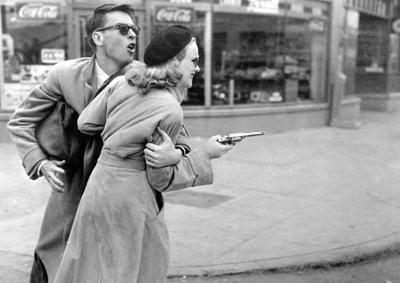"If you had to select a single film to justify the present enthusiasm for film noir and define its allure, few movies could compete with Gun Crazy." - Richard T. Jameson
"Joseph H. Lewis's direction is propulsive, possessed of a confident, vigorous simplicity that all the frantic editing and visual pyrotechnics of the filmmaking progeny never quite surpassed." - Eddie Muller, Film Noir Foundation
Directed by Joseph H. Lewis
Bart Tare loves guns and is caught stealing one at age fourteen. After stints in reform school and the Army, Bart returns home where he meets Annie Laurie Starr, who works as a sharpshooter at a local carnival. It is love at first gunsight. They consummate their relationship with a shooting match. It is all about guns and sex, sex and guns. The fact that she says she’s a bad girl who may have been involved in prostitution and murder hardly seems to matter. They rob to make a living, eventually planning a major heist that they pull off successfully, but not before Laurie has killed two people, putting the FBI on their tail.
Long before Michael Moore analyzed America’s pathological love affair with guns, Joseph H. Lewis and Dalton Trumbo nailed it with this dirty little film noir, which loosely adapts the story of Bonnie and Clyde. Dalton Trumbo, who was blacklisted and had to use the nom de plume Millard Kaufman as a front, rewrote MacKinlay Kantor’s 1940 Saturday Evening Post story, putting the focus on the film’s amour fou. Originally produced on virtually no budget for Monogram by the King Brothers, the crime drama was eventually released by United Artists and therefore gained more exposure than many B-films. The film’s major set piece, for which it has become justifiably famous, is a bank robbery, shot in Montrose, California in one long take. With the camera sitting in the back of the car, the lovers drive into town, park, rob the bank, and make their getaway. Andrew Sarris celebrated the scene and the director in "The American Cinema." Indeed, it was location shooting that gave the film its realism and made it stand out from the usual studio-bound product. The film has been on almost everyone’s best of noir list in the past decade and was placed on the National Film Registry in 1998.
Jan Christopher Horak
King Brothers Productions Inc./Allied Artists Pictures Corporation. Producers: Maurice King and Frank King. Screenwriters: MacKinlay Kantor and Dalton Trumbo (fronted by Millard Kaufman). From a story by: MacKinlay Kantor. Cinematographer: Russell Harlan. Editor: Harry W. Gerstad. Music: Victor Young. With: Peggy Cummins, John Dall, Berry Kroeger, Morris Carnovsky, Russ Tamblyn.
35mm, b/w, 86 min.
Preserved in cooperation with Warner Bros. from the original 35mm picture and track negatives. Laboratory services by The Stanford Theatre Film Laboratory, YCM Laboratories, Audio Mechanics, DJ Audio, Simon Daniel Sound. Special thanks to Ned Price.






 Mobile Navigation
Mobile Navigation

